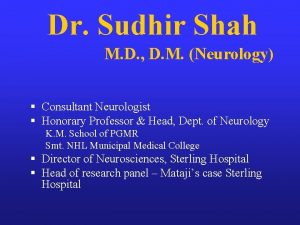Gang Leader for a Day Sudhir Venkatesh Penguin







- Slides: 7

Gang Leader for a Day Sudhir Venkatesh, Penguin Books, 2008 1

Chicago School (of Sociology) § § § Emerged in 1920 s – 1930 s Specialized in urban sociology Used ethnographic techniques, immersed selves in local settings Focused on micro-level interaction Emphasized individual’s relation to immediate social environment, small units like family, workplace, neighborhood, local community groups Saw sociology leading to social reform 2

African Americans in Chicago § “Great Migrations” from 1910 -1960 brought § § hundreds of thousands of blacks from the South to Chicago White hostility and population growth combined to create a black ghetto on the South Side The “Black Belt” of Chicago was the chain of neighborhoods on the South Side where 3/4 s of the city's African American population lived by the mid-20 th century 3

William Julius Wilson § African American Professor of Sociology at U of Chicago (1972 -1996), then Harvard § The Declining Significance of Race: Blacks and Changing American Institutions (1978) § argues that significance of race is waning, and an African. American's class is comparatively more important in determining his/her life chances § § The Truly Disadvantaged: The Inner City, the Underclass, and Public Policy (1987) When Work Disappears: The World of the New Urban Poor (1996) 4

“Culture of poverty” § § Tried to explain why generations of poor people reproduce same circumstances In 1965, Senator Daniel Patrick Moynihan (D) wondered why African Americans weren’t participating in the “affluent society”? § § § Weak family structure: "the fundamental problem is that of family structure, that the negro family in the urban ghettos is crumbling. “ Rejection of values around self-reliance and work Generally, liberals say it’s discrimination by whites, conservatives say it’s behavior of blacks 5

Crack epidemic § Decimated urban neighborhoods, in 1980 s, peaking early in the 90 s § First “crack babies” born in 1984 § Epidemic ends after early 90 s peak, being called a "crackhead" became an insult § Many children from the new generation stayed away from crack and never tried it themselves. Alfred Blumstein, a criminologist from Carnegie Mellon University stated the following 4 factors for the end of the epidemic: 1) getting guns out of the hands of kids 2) shrinking of the crack markets and their institutionalization 3) robustness of the economy – “There are jobs for kids now who might otherwise be attracted to dealing" 4) the criminal justice response, or as he puts it, "incapacitation related to the growth of incarceration" 6

Crime and Mass Incarceration § 1 in 45 adults in the United States is now under criminal justice supervision in the community, and that combined with those in prison and jail, a stunning 1 in every 31 adults, or 3. 2 percent, is under some form of correctional control (Pew Center on the States, “ 1 in 31, ” 2008) § The rates are drastically elevated for men (1 in 18) and blacks (1 in 11) and are even higher in some high-crime inner-city neighborhoods § Recent books by Michelle Alexander (The New Jim Crow, 2010) and Douglas Blackmon (Slavery by Another Name, 2008) argue mass incarceration of blacks is parallel to enslavement and peonage laws 7













